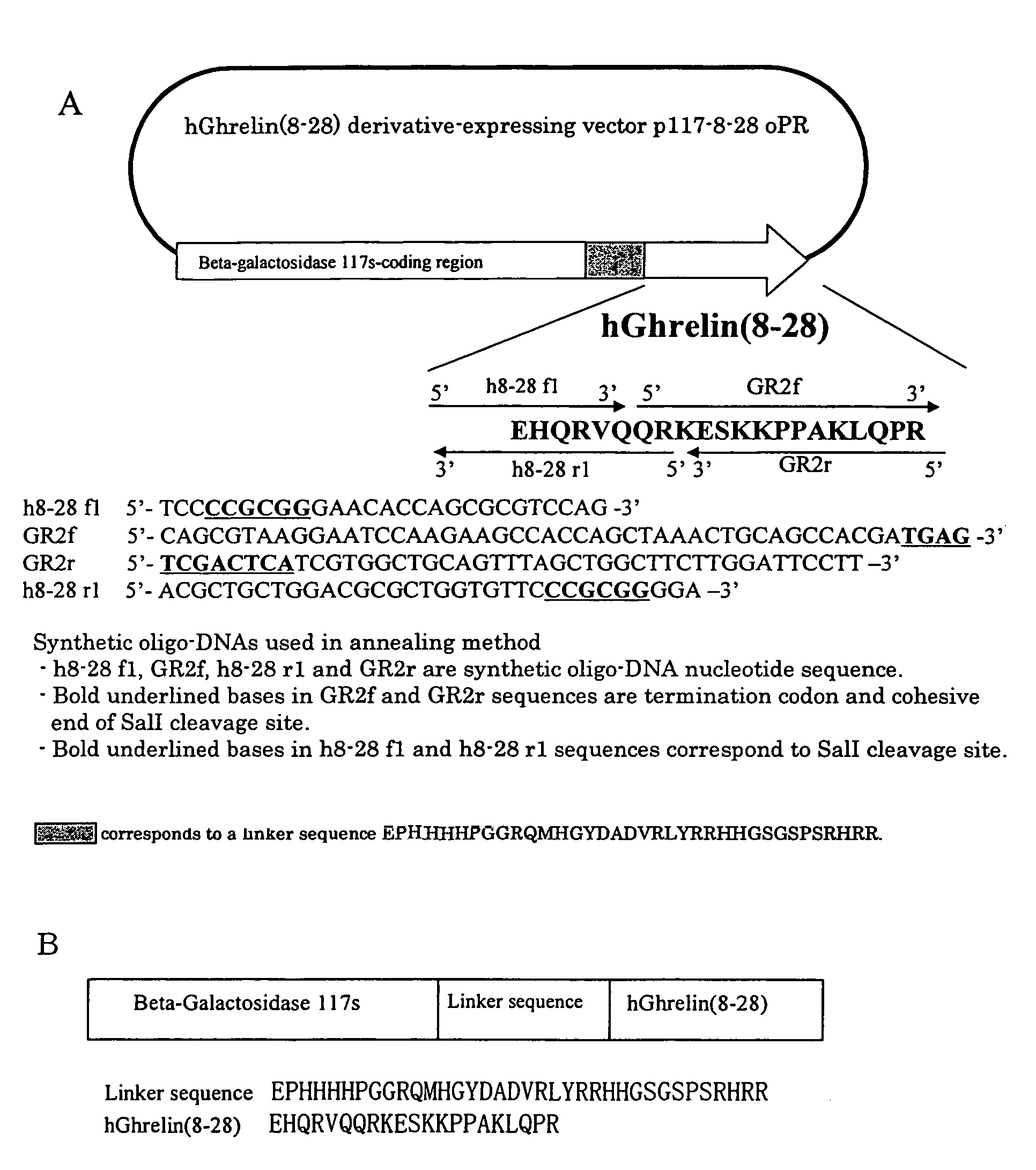Method for producing a modified peptide
a technology of peptides and peptides, applied in the direction of peptides, peptide sources, peptide/protein ingredients, etc., to achieve the effect of high quality, simple and effective, and effective production of modified peptides
- Summary
- Abstract
- Description
- Claims
- Application Information
AI Technical Summary
Benefits of technology
Problems solved by technology
Method used
Image
Examples
example 1
Construction of hGhrelin (8–28) Derivative Expression Vector p117 8–28oRR
[0253]Based on a cDNA gene sequence of hGhrelin (Kojima et al., Nature, vol. 402, p. 656–660, 1999), a DNA fragment of hGhrelin (8–28) was obtained using a total synthetic oligo-DNA (Pharmacia Biotech) by an annealing method. A total synthetic oligo-DNA and an amino acid sequence used for annealing are shown in FIG. 1A.
[0254]In order to insert this DNA fragment into a plasmid pGP117ompPR in which a gene of a fusion protein of Escherichia coli β-galactosidase derivative and human glucagon like peptide-1 had been introduced (International Publication No. WO 00 / 52193), pGP117ompPR was treated with restriction enzymes SalI and SacII, and subjected to agar gel electrophoresis to prepare a DNA fragment lacking a human glucagon like peptide-1 gene. After further treatment with alkaline phosphatase, this was ligated with a hGhrelin (8–28) derivative gene fragment which had been subjected to SacII treatment and T4 DNA k...
example 2
Expression of Recombinant hGhrelin (8–28) Fusion Protein in Escherichia coli and Recovery of Inclusion Bodies
[0257]The plasmid p117 8–28oRR made in Example 1 was transformed into Escherichia coli W3110 strain, and the transformed Escherichia coli was used to perform culturing at 2 L medium in a 3 L fermenter. This expression plasmid is a plasmid derived from pBR322, and expression thereof is induced with a lac promoter. In addition, the plasmid retains a tetracycline resistant gene as a drug resistance gene. The preculture was carried out in a LB broth by shaking at 32° C. for 14 hours. In the present culturing, a medium having the following composition was used. The medium composition is 4 g / L yeast extract, 4 g / L K2HPO4,4 g / L KH2PO4, 2.7 g / L Na2HPO4, 0.2 g / L NH4Cl, 1.2 g / L (NH4)2SO4, 2 g / L MgSO4.7H2O, 40 mg / L CaCl2, 40 mg / L FeSO4.7H2O, 10 mg / L MnSO4.nH2O, 10 mg / L AlCl3.6H2O, 4 mg / L CoCl2.6H2O, 2 mg / L ZnSO4.7H2O, 2 mg / L Na2MoO4.2H2O, 1 mg / L CuCl2.2H2O, 0.5 mg / L H3BO4. Glucose as a ...
example 3
Processing of hGhrelin (8–28) Fusion Protein with Endogenous OmpT Protease
[0259]The inclusion body suspension obtained in Example 2 was diluted with additives and deionized water shown in the following reaction conditions so that a value of OD660 became 100.0, and an OmpT reaction was performed under the following reaction conditions.
Reaction Conditions:
[0260]4M urea, 20 mM Tris-HCl pH 7.4, 50 mM NaCl, reaction volume: 800 mL, reaction temperature 32° C., reaction time 40 minutes
[0261]The inclusion bodies were dissolved and diluted with 400 mL of 8M urea to 100OD660 / mL, Tris-HCl and NaCl were added to the solution, and measured up with deionized water to 800 mL. Further, a pH was adjusted to 7.4 to initiate a reaction. At 0 minute, 20 minutes and 40 minutes from reaction initiation, sampling was performed, analysis was performed by HPLC, and the reaction was stopped at 40 minutes, at which a cleavage rate exceeded 80%. The reaction was stopped by increasing a pH to 11 with 5N NaOH. ...
PUM
| Property | Measurement | Unit |
|---|---|---|
| pH | aaaaa | aaaaa |
| reaction temperature | aaaaa | aaaaa |
| time | aaaaa | aaaaa |
Abstract
Description
Claims
Application Information
 Login to View More
Login to View More - R&D
- Intellectual Property
- Life Sciences
- Materials
- Tech Scout
- Unparalleled Data Quality
- Higher Quality Content
- 60% Fewer Hallucinations
Browse by: Latest US Patents, China's latest patents, Technical Efficacy Thesaurus, Application Domain, Technology Topic, Popular Technical Reports.
© 2025 PatSnap. All rights reserved.Legal|Privacy policy|Modern Slavery Act Transparency Statement|Sitemap|About US| Contact US: help@patsnap.com



